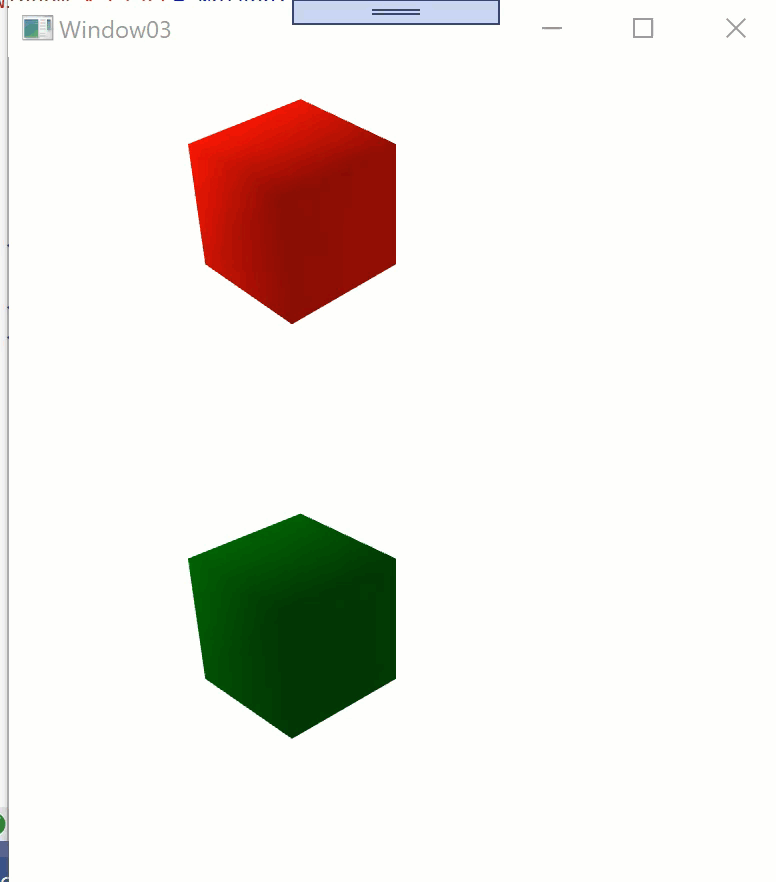Hi, without seeing your code I cannot reproduce your problems. Try following demo:
<Window x:Class="WpfApp1.Window03"
xmlns="http://schemas.microsoft.com/winfx/2006/xaml/presentation"
xmlns:x="http://schemas.microsoft.com/winfx/2006/xaml"
xmlns:d="http://schemas.microsoft.com/expression/blend/2008"
xmlns:mc="http://schemas.openxmlformats.org/markup-compatibility/2006"
xmlns:local="clr-namespace:WpfApp03"
mc:Ignorable="d"
Title="Window03" Height="450" Width="400">
<Window.DataContext>
<local:ViewModel/>
</Window.DataContext>
<Grid>
<Grid.RowDefinitions>
<RowDefinition/>
<RowDefinition/>
</Grid.RowDefinitions>
<Viewport3D Grid.Row="0" local:ViewModel.Reference="True">
<Viewport3D.Camera>
<PerspectiveCamera Position="-40,40,40" LookDirection="40,-40,-40 "
UpDirection="0,0,1" />
</Viewport3D.Camera>
<ModelVisual3D>
<ModelVisual3D.Content>
<Model3DGroup>
<DirectionalLight Color="White" Direction="-1,-1,-3" />
<GeometryModel3D>
<GeometryModel3D.Geometry>
<MeshGeometry3D Positions="0,0,0 10,0,0 10,10,0 0,10,0 0,0,10
10,0,10 10,10,10 0,10,10"
TriangleIndices="0 1 3 1 2 3 0 4 3 4 7 3 4 6 7 4 5 6
0 4 1 1 4 5 1 2 6 6 5 1 2 3 7 7 6 2"/>
</GeometryModel3D.Geometry>
<GeometryModel3D.Material>
<DiffuseMaterial Brush="Red"/>
</GeometryModel3D.Material>
</GeometryModel3D>
</Model3DGroup>
</ModelVisual3D.Content>
</ModelVisual3D>
</Viewport3D>
<Viewport3D Grid.Row="1" local:ViewModel.Reference="True">
<Viewport3D.Camera>
<PerspectiveCamera Position="-40,40,40" LookDirection="40,-40,-40 "
UpDirection="0,0,1" />
</Viewport3D.Camera>
<ModelVisual3D>
<ModelVisual3D.Content>
<Model3DGroup>
<DirectionalLight Color="White" Direction="-1,-1,-3" />
<GeometryModel3D>
<GeometryModel3D.Geometry>
<MeshGeometry3D Positions="0,0,0 10,0,0 10,10,0 0,10,0 0,0,10
10,0,10 10,10,10 0,10,10"
TriangleIndices="0 1 3 1 2 3 0 4 3 4 7 3 4 6 7 4 5 6
0 4 1 1 4 5 1 2 6 6 5 1 2 3 7 7 6 2"/>
</GeometryModel3D.Geometry>
<GeometryModel3D.Material>
<DiffuseMaterial Brush="Green"/>
</GeometryModel3D.Material>
</GeometryModel3D>
</Model3DGroup>
</ModelVisual3D.Content>
</ModelVisual3D>
</Viewport3D>
</Grid>
</Window>
--------------------------------------
using System;
using System.Collections.Generic;
using System.Linq;
using System.Windows;
using System.Windows.Controls;
using System.Windows.Input;
using System.Windows.Media.Media3D;
namespace WpfApp03
{
public class ViewModel
{
List<MyViewPort> ViewPorts = new List<MyViewPort>();
public static readonly DependencyProperty ReferenceProperty =
DependencyProperty.RegisterAttached("Reference", typeof(bool),
typeof(FrameworkElement),
new UIPropertyMetadata(false, OnReferenceChanged));
public static bool GetReference(DependencyObject obj) => (bool)obj.GetValue(ReferenceProperty);
public static void SetReference(DependencyObject obj, bool value) => obj.SetValue(ReferenceProperty, value);
private static void OnReferenceChanged(DependencyObject depObj, DependencyPropertyChangedEventArgs e)
{
var vp = depObj as Viewport3D;
if (vp == null || !(e.NewValue is Boolean)) return;
var vm = vp.DataContext as ViewModel;
if (vm.ViewPorts.Count == 0 || vm.ViewPorts.Where((v) => v.VPort == vp).Count() == 0)
vm.ViewPorts.Add(new MyViewPort() { VPort = vp });
}
}
public class MyViewPort
{
private Viewport3D _vPort;
public Viewport3D VPort
{
get => this._vPort;
set
{
if (this._vPort == null)
{
this._vPort = value;
this._vPort.MouseDown += _vPort_MouseDown;
this._vPort.MouseMove += _vPort_MouseMove;
this._vPort.MouseUp += _vPort_MouseUp;
this._vPort.Loaded += _vPort_Loaded;
}
}
}
private AxisAngleRotation3D rot = new AxisAngleRotation3D(new Vector3D(0, 2, 0), 0);
private void _vPort_Loaded(object sender, RoutedEventArgs e)
{
var mod = this._vPort.Children[0] as ModelVisual3D;
mod.Transform = new RotateTransform3D(rot);
}
private Point pt = new Point(double.NaN, double.NaN);
private void _vPort_MouseDown(object sender, MouseButtonEventArgs e) => pt = e.GetPosition(this._vPort);
private void _vPort_MouseMove(object sender, MouseEventArgs e)
{
if (!double.IsNaN(pt.X))
{
Point pt1 = e.GetPosition(this._vPort);
double ang = pt1.X - pt.X;
rot.Angle = ang;
}
}
private void _vPort_MouseUp(object sender, MouseButtonEventArgs e)=> pt = new Point(double.NaN, double.NaN);
}
}


